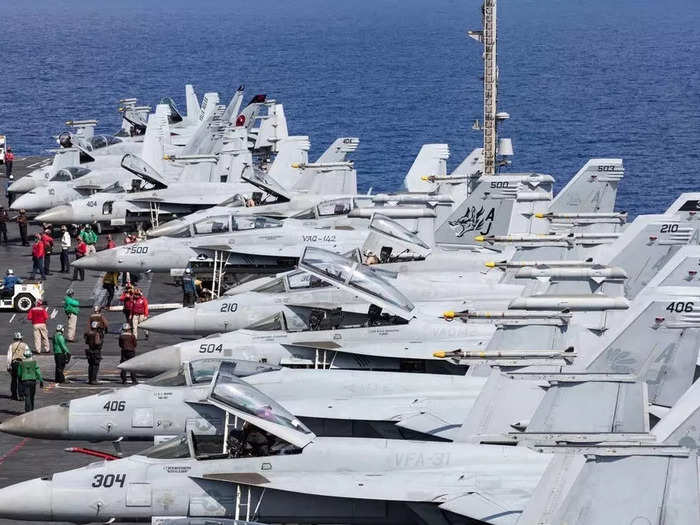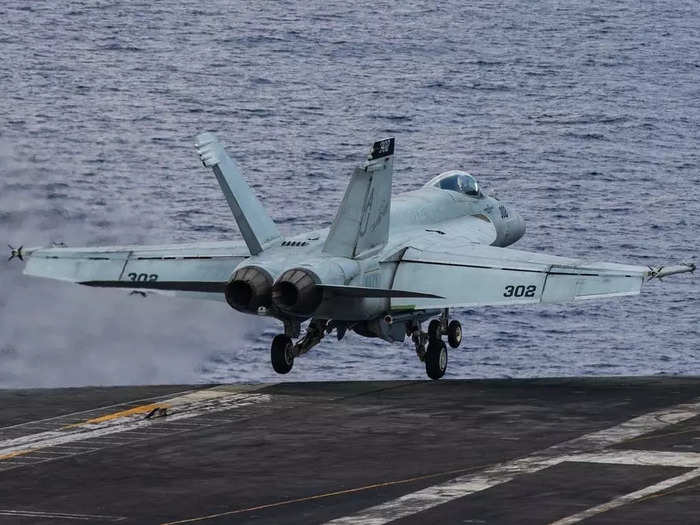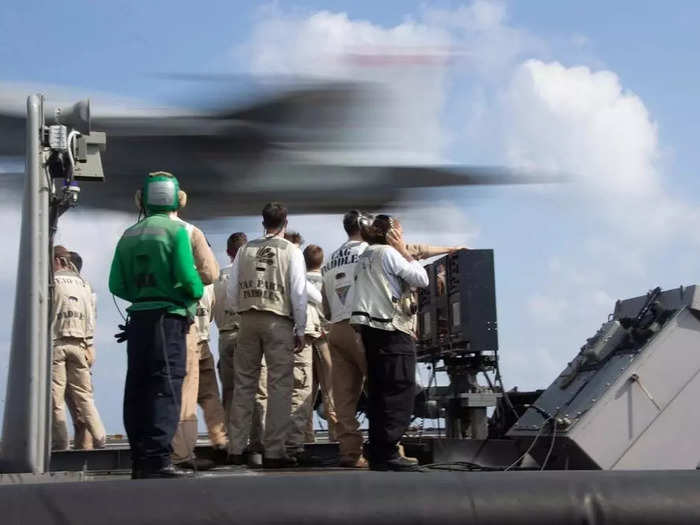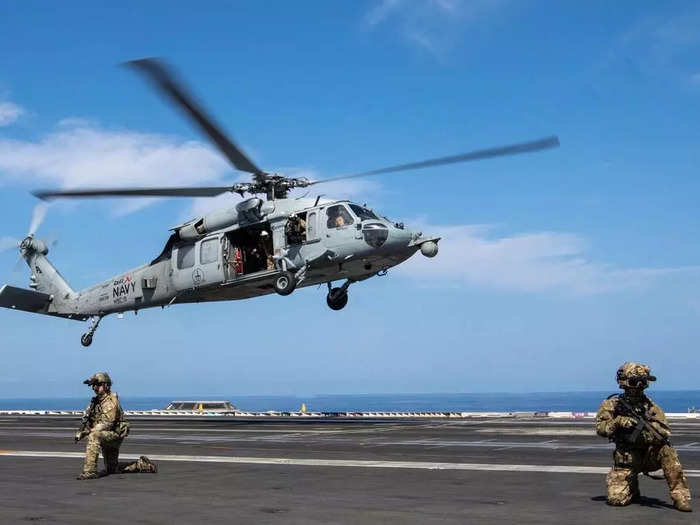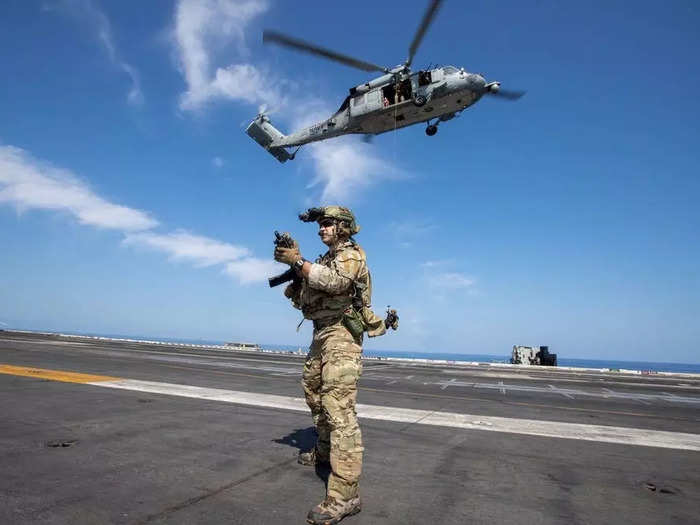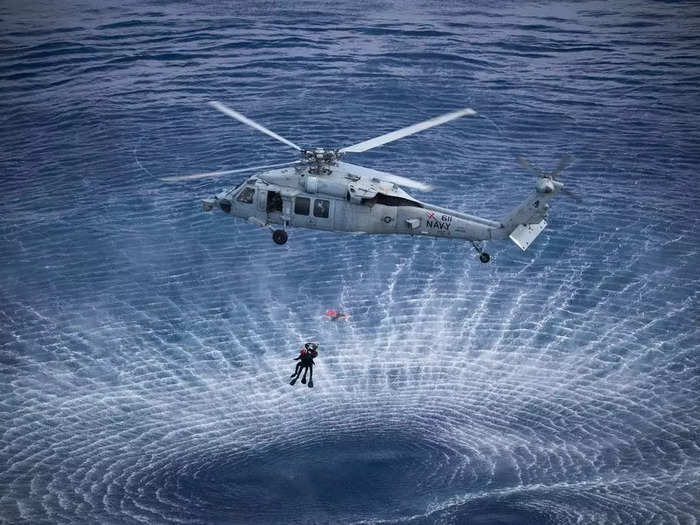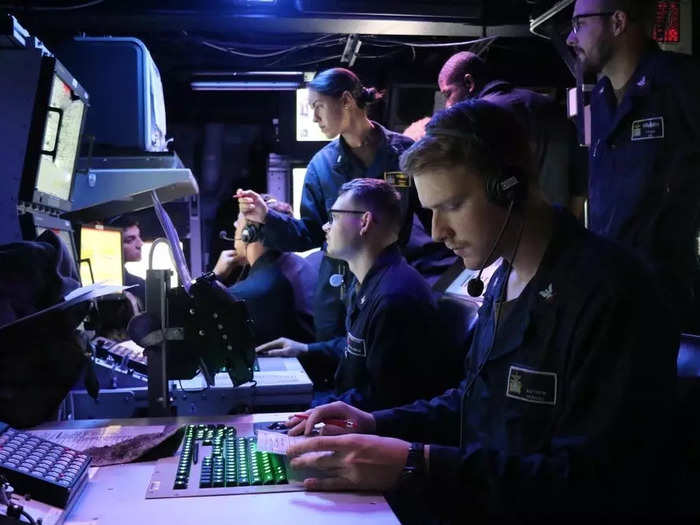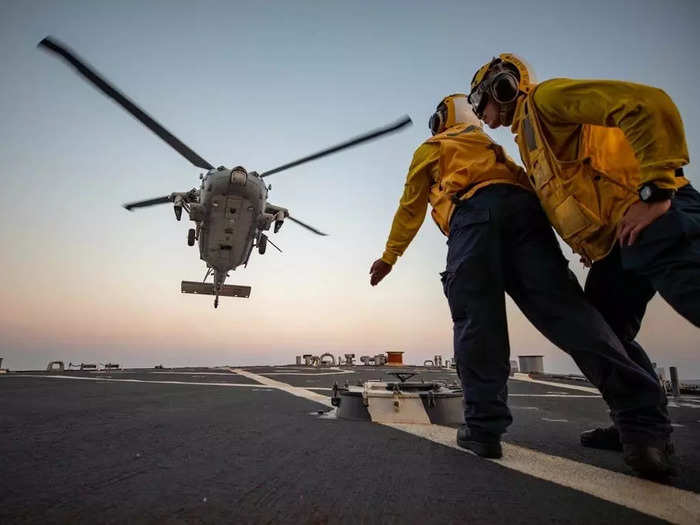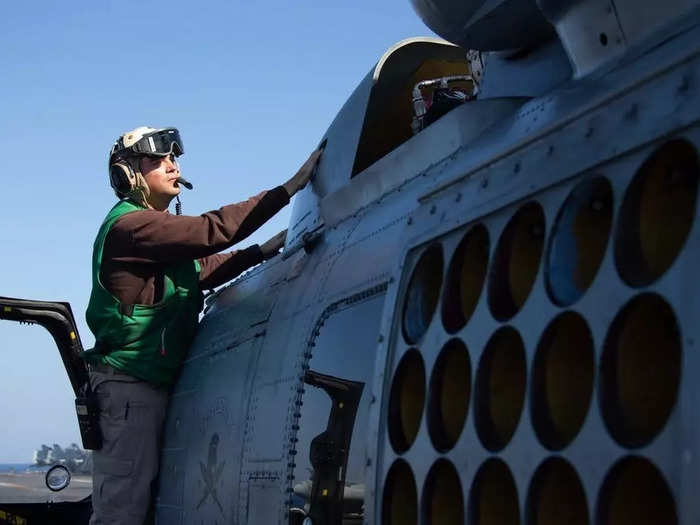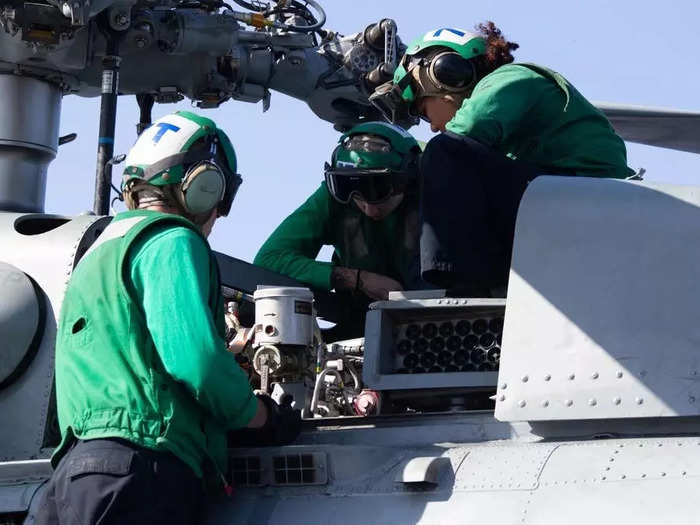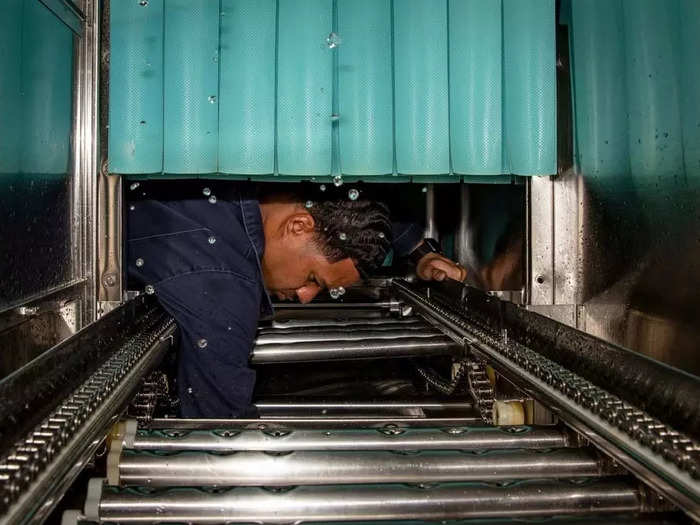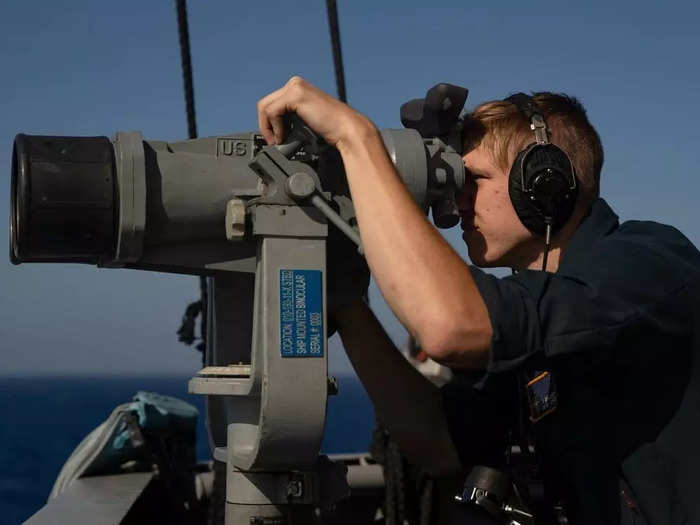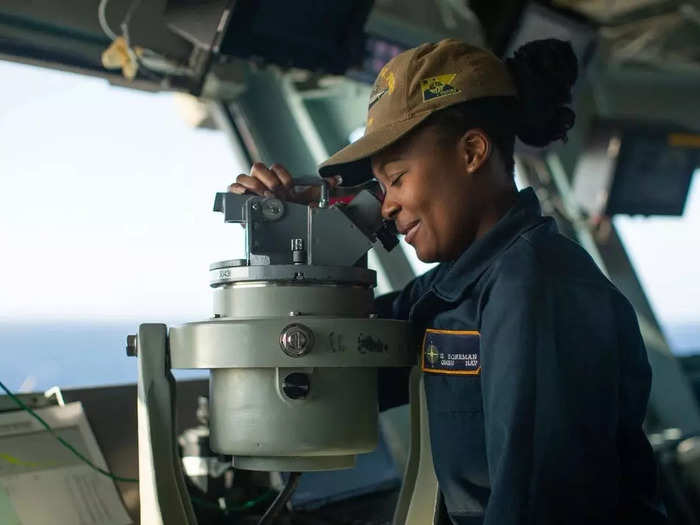Aviation Boatswain's Mate stands as the enlisted landing signalman while an E-2D Hawkeye prepares to land on Gerald R. Ford's flight deck.Petty Officer 2nd Class Jacob Mattingly/DVIDS
- The USS Gerald R. Ford entered the East Mediterranean Sea this week.
- The carrier and its strike force are part of US aid to Israel.
The US announced on October 8 that it would be sending its most advanced aircraft carrier — USS Gerald R. Ford — and its attached strike group toward Israel. The carrier has joined a cruiser and a handful of destroyers.
The decision to send the carrier strike group came after Hamas militants attacked Israel on October 7 and killed 1,400 people. Israel responded with airstrikes that have killed more than 3,000 Palestinian people and injured nearly 14,000 in Gaza, according to Tuesday data from the United Nations Office for the Coordination of Humanitarian Affairs.
The presence of the USS Gerald R. Ford in waters near Israel, where it arrived last Tuesday, serves to "deter any actor seeking to escalate the situation or widen this war," according to a statement from US Central Command.
Here's a look onboard the USS Gerald R. Ford while it's stationed in the Eastern Mediterranean.
The USS Gerald R. Ford can carry F/A-18 Super Hornets as part of its air wing.
F/A-18 Super Hornets, prepare for flight operations on the flight deck of the world's largest aircraft carrier on October 14, 2023. Seaman Maxwell Orlosky/DVIDS
F/A-18 Super Hornets are improvements from their predecessors, the F14-Tomcat, a twin-engine, two-seat fighter aircraft used for air superiority and fleet defense. The Super Hornets bring a wider mission versatility for missions like fighter escorts, reconnaissance, aerial refueling, and precision strikes.
The Super Hornet was designed to carry more munitions and fuel, giving it greater range and combat power than its predecessor.
The Super Hornets are able to perform "virtually every mission in the tactical spectrum, including air superiority, day/night strike with precision-guided weapons, fighter escort, close air support, suppression of enemy air defenses, maritime strike, reconnaissance, forward air control and tanker missions," according to Boeing.
The F/A-18 Super Hornets are not the only fighters on the USS Gerald R. Ford.
An F/A-18 takes off from the USS Gerald R. Ford on October 13, 2023. Seaman Maxwell Orlosky/DVIDS
Carrier Airwing 8, the air wing attached to the USS Gerald R. Ford, is tasked with providing offensive aerial support against land and sea targets.
Included in their arsenal are also electronic warfare Growlers, Hawkeye early warning planes, and rotary aircraft like the MH-60R Seahawk.
While USS Gerald R. Ford is in the Eastern Mediterranean, crews are conducting various exercises.
Sailors observe an F/A-18E Super Hornet landing on the flight deck in the Eastern Mediterranean on October 13, 2023. Petty Officer 2nd Class Jacob Mattingly/DVIDS
These include hoisting exercises conducted by the Helicopter Sea Combat Squadron using the MH-60S Sea Hawk.
An MH-60S Sea Hawk conducts hoisting exercises aboard the USS Gerald R. Ford on October 11, 2023. Seaman Maxwell Orlosky/DVIDS
Hoisting exercises help soldiers learn helicopter rescue procedures.
A helicopter hoists someone in the air while a soldier stands guard, on October 11, 2023 Seaman Maxwell Orlosky/DVIDS
Hoist training reinforces training in a dangerous skill to ensure there are no mistakes when the time comes to use it. Hoists are reserved for when rescuers can't land their helicopter due to dangerous or unfavorable conditions.
While the pilot keeps the helicopter at a hover with minimal changes in altitude, a medic repels down and provides aid for the wounded before hoisting themselves and the patient back up.
Sailors are also conducting simulated search and rescue exercises in the Mediterranean Sea.
Sailors perform a simulated search and rescue exercise in the Eastern Mediterranean Sea, on October 11, 2023 Petty Officer 2nd Class Jackson Adkins
Air Med and Rescue Magazine reported that soldiers often complete "extensive survival, evasion, resistance, and escape (SERE) training."
The training prepares sailors to rescue downed pilots, overboard sailors, and others who may need rescuing. Similarly to hoist training, a helicopter hovers above a point in the ocean while someone rappels down to administer aid.
On other ships in the strike group, the crew is conducting their own training and operations.
Sailors aboard the guided-missile destroyer USS Thomas Hudner conduct strike scenarios on October 11, 2023 Petty Officer 3rd Class Kerri Kline/DVIDS
USS Thomas Hudner is an Arleigh Burke-class guided-missile destroyer. Sailors onboard have been conducting strike scenarios while in the Eastern Mediterranean.
On USS Carney, another destroyer, sailors have been running flight operations with Helicopter Sea Combat Squadron 9.
Boatswain's Mate 2nd Class Owen Johnson, left, and Boatswain's Mate 3rd Class Andrew Gonzalez guide an MH-60S Sea Hawk helicopter during flight operations, October 12, 2023. Petty Officer 2nd Class Aaron Lau/DVIDS
In addition to training exercises, personnel have been conducting maintenance and repairs to the carrier's various assets.
Senior Chief Aviation Structural Mechanic Matthew Haney closes the cover to a rotor assembly of an MH-60R Sea Hawk, October 10, 2023. Petty Officer 2nd Class Jacob Mattingly/DVIDS
Maintenance can include checking the rotor assembly of a helicopter.
Sailors perform routine maintenance on a rotor assembly of an MH-60R Sea Hawk, on October 10, 2023. Petty Officer 2nd Class Jacob Mattingly/DVIDS
Or cleaning the rotor blades to clear debris and ensure smooth operation.
Aviation Structural Mechanic Airman Shea Fortin washes down an MH-60S Sea Hawk, October 10, 2023. Petty Officer 2nd Class Jacob Mattingly/DVIDS
Smaller everyday tasks, like fixing the dishwasher, are also essential in the strike group.
Chief Electrician's Mate Oneil Williams reaches inside the ship's dishwasher to fix a heating element, October 11, 2023. Petty Officer 2nd Class Malachi Lakey/DVIDS
Other daily tasks include identifying surface and air contacts from the deck.
Boatswain's Mate Seaman Apprentice Jason Guldseth uses a mounted binocular to identify surface and air contacts, October 10, 2023. Petty Officer 2nd Class Nolan Pennington/DVIDS
As well as the essential responsibilities of navigation.
Quartermaster Seaman Javoniah Foreman uses an alidade in the pilot house to identify a surface contact's range and bearing in the Eastern Mediterranean Sea, October 10, 2023. Petty Officer 2nd Class Nolan Pennington/DVIDS

